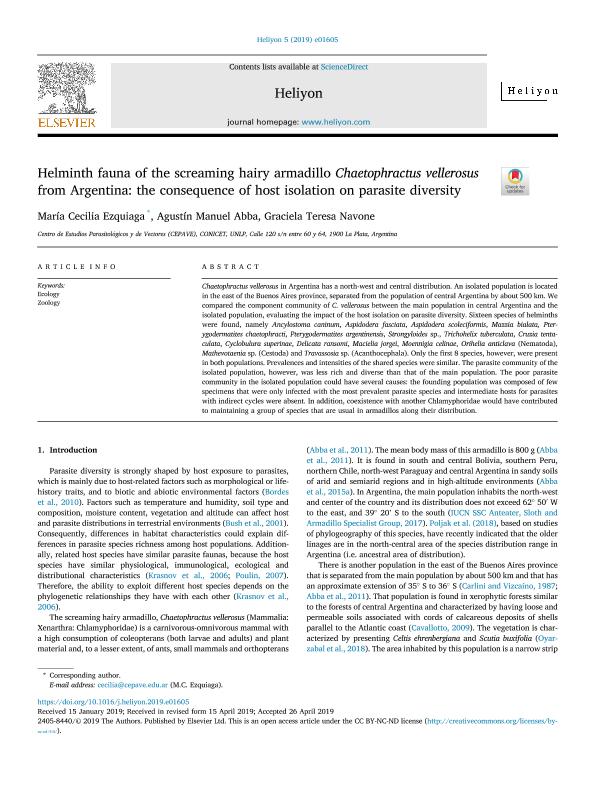Artículo
Helminth fauna of the screaming hairy armadillo Chaetophractus vellerosus from Argentina: the consequence of host isolation on parasite diversity
Fecha de publicación:
05/2019
Editorial:
Elsevier
Revista:
Heliyon
ISSN:
2405-8440
Idioma:
Inglés
Tipo de recurso:
Artículo publicado
Clasificación temática:
Resumen
Chaetophractus vellerosus in Argentina has a north-west and central distribution. An isolated population is located in the east of the Buenos Aires province, separated from the population of central Argentina by about 500 km. We compared the component community of C. vellerosus between the main population in central Argentina and the isolated population, evaluating the impact of the host isolation on parasite diversity. Sixteen species of helminths were found, namely Ancylostoma caninum, Aspidodera fasciata, Aspidodera scoleciformis, Mazzia bialata, Pterygodermatites chaetophracti, Pterygodermatites argentinensis, Strongyloides sp., Trichohelix tuberculata, Cruzia tentaculata, Cyclobulura superinae, Delicata ransomi, Macielia jorgei, Moennigia celinae, Orihelia anticlava (Nematoda), Mathevotaenia sp. (Cestoda) and Travassosia sp. (Acanthocephala). Only the first 8 species, however, were present in both populations. Prevalences and intensities of the shared species were similar. The parasite community of the isolated population, however, was less rich and diverse than that of the main population. The poor parasite community in the isolated population could have several causes: the founding population was composed of few specimens that were only infected with the most prevalent parasite species and intermediate hosts for parasites with indirect cycles were absent. In addition, coexistence with another Chlamyphoridae would have contributed to maintaining a group of species that are usual in armadillos along their distribution.
Archivos asociados
Licencia
Identificadores
Colecciones
Articulos(CEPAVE)
Articulos de CENTRO DE EST.PARASITOL.Y DE VECTORES (I)
Articulos de CENTRO DE EST.PARASITOL.Y DE VECTORES (I)
Citación
Ezquiaga, María Cecilia; Abba, Agustin Manuel; Navone, Graciela Teresa; Helminth fauna of the screaming hairy armadillo Chaetophractus vellerosus from Argentina: the consequence of host isolation on parasite diversity; Elsevier; Heliyon; 5; 5; 5-2019; 1-5
Compartir
Altmétricas




